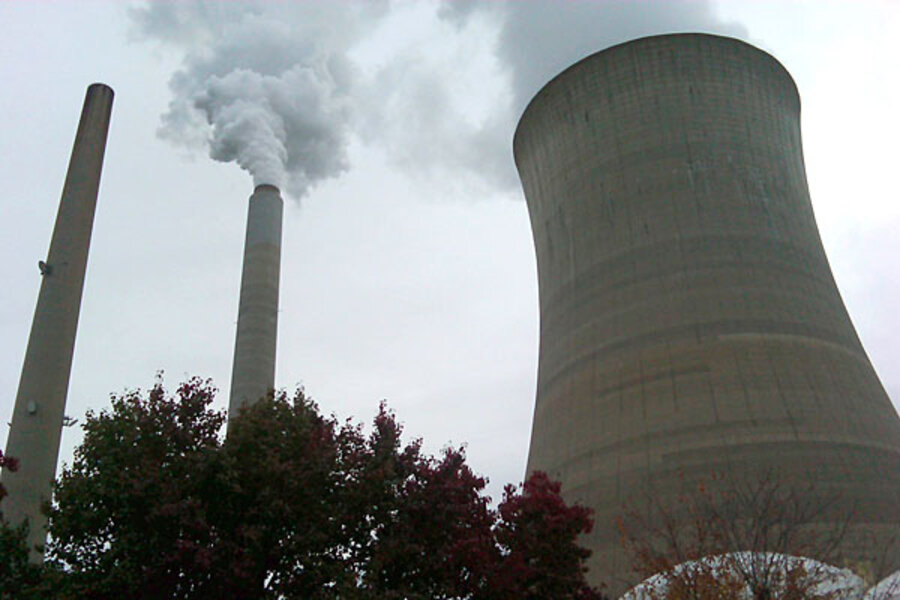EPA issues new rule on greenhouse gas emissions: Where does that leave coal?
Loading...
The Obama administration on Tuesday proposed the nation’s first-ever restrictions on greenhouse gas emissions from US power plants. If approved, the restrictions are expected to sharply curb construction of new coal-fired power plants nationwide.
The proposed restrictions, unveiled by officials at the Environmental Protection Agency, would apply only to new fossil-fuel-burning power plants – limiting them to no more than 1,000 pounds of carbon dioxide emissions per megawatt generated.
A typical coal-fired plant produces more than 1,700 pounds of carbon dioxide per megawatt. Most natural-gas fired plants – the majority of power plants under construction today – emit less than the new standard, around 800 pounds per megawatt.
The proposed restrictions were hailed by environmentalists but criticized by the coal industry as leading to higher electricity prices.
EPA officials stressed that the agency was abiding by a US Supreme Court mandate – and said the new rule should not be onerous because it follows industry trends toward cleaner power plants. The agency will soon open the rule to public comment, including public hearings, with an expected final rule late this year.
“Today we’re taking a common-sense step to reduce pollution in our air, protect the planet for our children, and move us into a new era of American energy,” said EPA Administrator Lisa Jackson. “We’re putting in place a standard that relies on the use of clean, American-made technology to tackle a challenge that we can’t leave to our kids and grandkids.”
At present, there is no uniform national limit on the amount of carbon emissions that new power plants can emit. The EPA noted in a fact sheet that the agency was compelled by a landmark 2007 Supreme Court ruling "to determine if [the emissions] threaten public health and welfare." In December 2009, the agency formally declared that greenhouse gases "endanger the public health and welfare of current and future generations."
Environmental groups praised the EPA’s announcement.
“EPA deserves a standing ovation for today's historic action to protect Americans’ health, strengthen our economy, and address the clear and present danger of carbon pollution,” Fred Krupp, president of the Environmental Defense Fund said in a statement. “The bottom line for our nation is that cleaner power will cut harmful carbon pollution, protect our children from dangerous smog and other serious climate impacts, and help secure a safe and prosperous future."
Ms. Jackson stressed that what EPA is doing is in keeping with existing trends. Several states, including Washington, Oregon and California, already limit greenhouse gas emissions, while Montana and Illinois currently require new coal plants to capture and store their emissions, EPA noted.
Meanwhile, next-generation power plants that burn coal more cleanly should be able to meet the proposed standard without add-on controls, the EPA maintained.
Scores of old, inefficient coal-fired power plants were already expected to close as a result of other air pollution regulations – with gas fired plants popping up in their place. According to industry experts, if coal loses out in utilities’ decisions on what to build, it would be because the economics of burning gas are simply better than burning coal.
“Gas is contributing to the closure of these [coal-fired] plants,” Dominion Resources chief executive Thomas F. Farrell II told the Washington Post. Mr. Farrell, who also chairs the Edison Electric Institute, the utility trade association, added: “It’s not all EPA. It’s a combination of low gas prices and EPA working at the same time.”
Coal-industry spokesmen and some lawmakers on Capitol Hill declared the move an economic disaster in the making that is certain to increase electricity rates nationwide.
"EPA’s proposal for controlling greenhouse gas emissions from about half the nation’s electric power supply is a poorly disguised cap-and-tax scheme that represents energy and economic policy at its worst," Hal Quinn, president of the National Mining Association said in a statement. "Higher utility bills and fewer jobs are the only certain outcomes from this reckless attempt to override Congress’s repeated refusal to enact punitive caps on carbon dioxide emissions."
Today, coal-fired power plants produce about 40 percent of the nation's electricity – and an equal portion of its greenhouse gas emissions. New coal-fired plants can meet the requirement by burying the carbon dioxide emissions and through other technologies, EPA says.
The rule "creates a path forward for new technologies to be deployed at future facilities that would allow companies to burn coal, while emitting less carbon pollution," an EPA fact sheet said. New power plants designed to use coal or petroleum coke would be able to "incorporate technology to reduce carbon dioxide emissions to meet the standard, such as carbon capture and storage (CCS)."
Still, some lawmakers were quick to condemn the EPA move and promised to try to reverse it.
Sen. Jim Inhofe (R) of Oklahoma was reported to be seeking a Congressional Review Act vote to halt the rule. Sen. John Barrasso (R) of Wyoming said “the Obama Administration just took another step to fulfill the president’s plan to make electricity ‘skyrocket’ and ‘bankrupt’ America’s coal industry."
But Rep. Henry Waxman (D) of California, who led the fight in the House to pass cap-and-trade legislation to limit greenhouse gas emissions – only to see that bill die in the Senate – declared the EPA’s proposed carbon pollution standards for new power plants "a breakthrough."
"It sets achievable limits on dangerous carbon pollution, spurs investments in new clean energy technologies, and provides certainty for industry," Congressman Waxman said in a statement. "It shows the president is listening to scientists, not extremists who deny the existence of climate change. Today’s action will reduce pollution, make families healthier, promote innovation, and help us compete with China and other countries that are investing in clean energy.”







